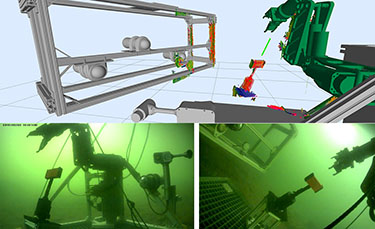|
Subscribe / Renew |
|
|
Contact Us |
|
| ► Subscribe to our Free Weekly Newsletter | |
| home | Welcome, sign in or click here to subscribe. | login |
Environment
| |
 |
September 29, 2016
Robots go where no divers can to recover munitions
Kane Environmental

Kane
|
Kane Environmental and Kane Remediation Technologies are working with a Fremont-based robotics software company, BluHaptics, to apply its new software system using remotely operated vehicles (ROVs) to identify and remove munitions from the sea floor and to sample remote deep water sediment where human divers cannot go.
BluHaptics developed the software that uses data fusion, machine learning and control technology to make ROV operations more efficient. The software works with a wide variety of ROVs, sensors and manipulator arms, which allow for operation in the most challenging conditions, such as high turbidity.
Imagine being able to control the ROV from a ship, in over 2,000 feet of water, and use the software to see the munitions in 3-D, identify the munitions type using machine learning, and safely retrieve the munitions using BluHaptics “pilot assist” from depths where no diver can safely go.
The key innovation behind the pilot assist feature is the use of assistive force feedback designed to guide the pilot towards the ideal position and orientation required for precision grasping.
BluHaptics uses real-time 3-D sensor data to:
• Generate optimal visual and force feedback depending on each situation.
• Track the operation in real-time and notify the pilot of unexpected events.
• Provide the pilot with the option to re-plan operations on the fly or, if necessary, abort.
This is only one of the uses of the BluHaptics’ new technology, and due to the increased safety, efficiency and significant cost-savings of the approach, we expect this to be the standard of the industry very soon.
John R. Kane is CEO and president of Kane Environmental and Kane Remediation Technologies in Seattle.
Other Stories:
- 3 things to consider about your building materials
- Survey: SoundEarth Strategies
- Survey: Coho Water Resources
- Survey: Landau Associates
- Survey: Shannon & Wilson
- Survey: Hart Crowser
- Still much to learn about the carbon story of buildings
- Brownfields are becoming developers’ next frontier
- With Passive House, incentives are all carrot and no stick
- New water plant saves Lynden from the ‘milkshake effect’
- Restoring an ecosystem? Get to know your geotech
- Reusing stormwater can release untapped benefits
- Navigating Washington’s water rights process
- Survey: Evergreen Certified



